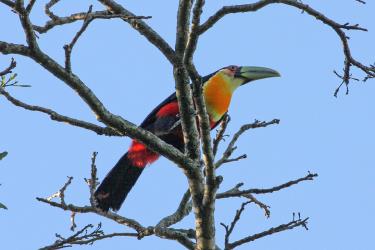The green-billed toucan (Ramphastos dicolorus), or red-breasted toucan, is a near-passerine bird in the family Ramphastidae found in southern and eastern Brazil, Pantanal of Bolivia, eastern Paraguay and far north-eastern Argentina. It is primarily found in the Atlantic Forest. Overall, it is fairly common, and therefore considered to be of least concern by IUCN.
It is one of the smallest species of Ramphastos toucans, weighing 265–400 g (9.3–14.1 oz) and measuring 40–46 cm (15.5–18 in) long in total. Its beak is one of the shortest of Ramphastos toucans at only about 10 cm (3.9 in) in length. Its breast is actually orange, with yellow at the sides. The beak is mostly pale greenish-horn, leading to its common name. In aviculture, their requirement of spacious cages, a high fruit diet and sensitivity to hemochromatosis (iron storage disease) make them difficult to maintain for novice keepers.
Ecological Role
The green-billed toucan (Ramphastos dicolorus), or red-breasted toucan typically feeds on a wide range of fruits and plants, therefore largely contributing to seed dispersal in the subtropical Atlantic forest. This species further fulfills the role of a nest predator, participating in predation of the eggs of other bird species. Ramphastos dicolorus are also considered prey by carnivorous birds.
Nest Construction
The green-billed toucans are obligatory cavity nesters, so they build nests in the uninhabited cavities made by woodpeckers. This species has also been known to take over cavities if they have been previously inhabited by other organisms.
Typically, Ramphastos dicolorus occupy cavities in living trees and can be found anywhere from 121 to 580 cm off of the ground. Living trees as well as nest entrance size were significant in determining green-billed toucan survival, as living trees with smaller entrance sizes provide the species with greater protection from larger predators. Height above the ground is not significant in terms of nest survival, hence the large range in nest height.
Parental Attendance
Bi parental care was observed in the green-billed toucan (Ramphastos dicolorus), or red-breasted toucan. There was no significant difference found between the duration of egg incubation for males versus females (female 27.5 ± 22.4 min/ h, male 28.2 ± 20.5 min/ h). During the nestling stage, visits by the female were significantly higher than by the male (female 32.5 ± 10.5 min/ h, and male 19.2 ± 9.2 min/ h), however both parents were seen bringing food to the young.


